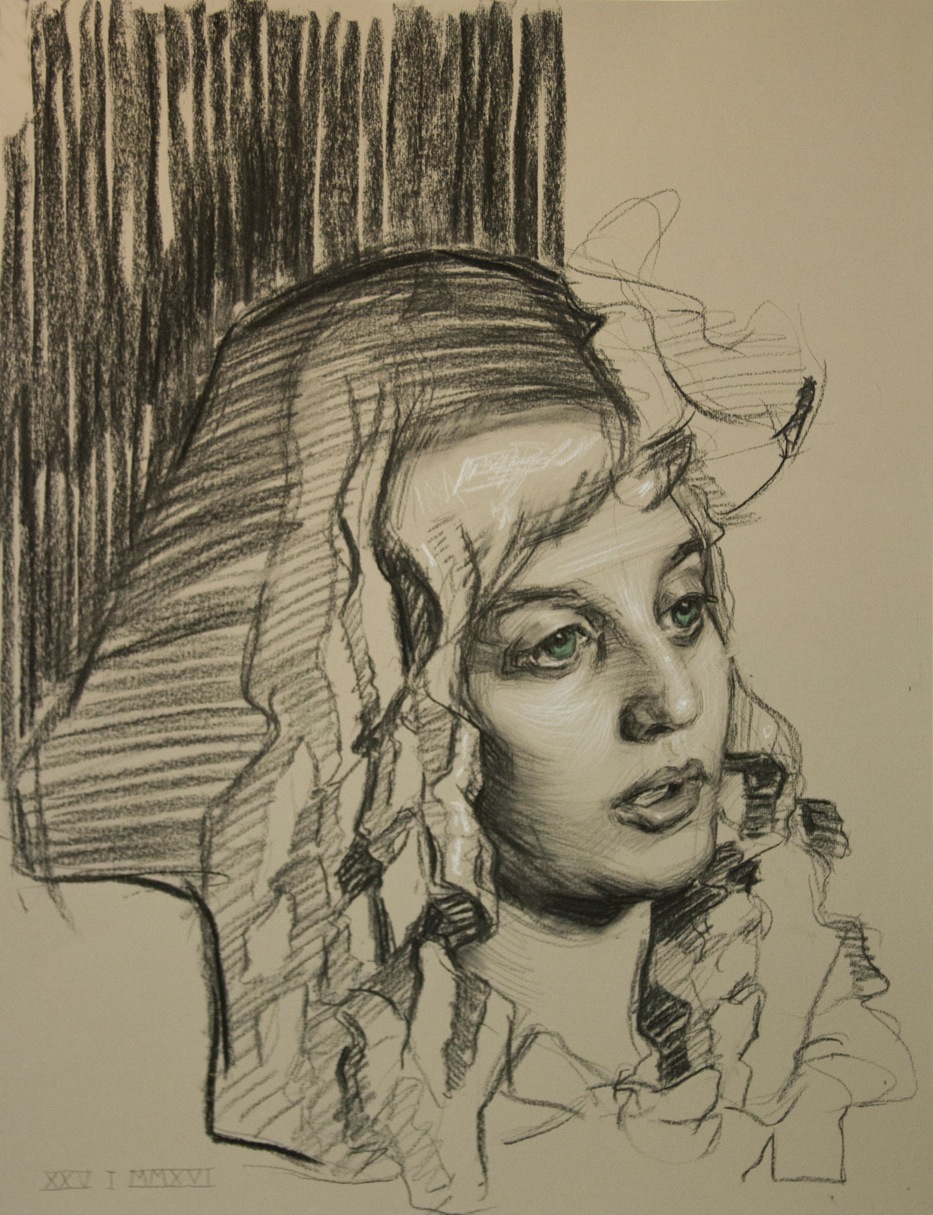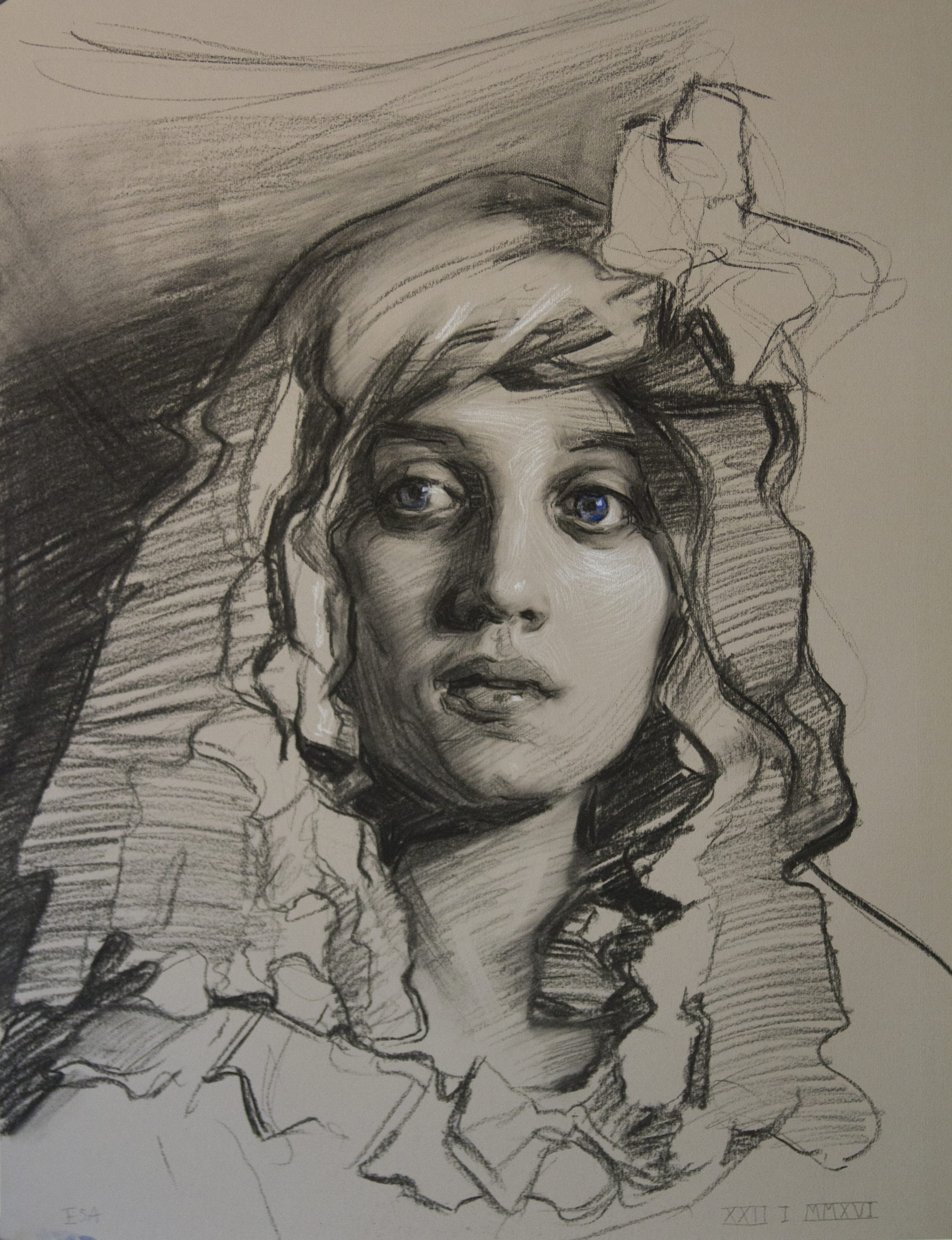On drawing with charcoal > Teresa Oaxaca shares why she finds working with charcoal “refreshing” when it comes to drawing portraits.
Mark Making in Charcoal
BY TERESA OAXACA

Whenever I get fatigued I turn to charcoal. From staying up too many nights in a row pushing a new piece, deadline crunching, or attempting to broaden the mind by showing up for art talks, openings, conferences and workshops, my brain demands a place to retreat and recharge.
With some of my leading inspirations being John Singer Sargent and Antonio Mancini, I have sought to explore the role of line work as both a shading device and a planal accent existing outside its role in tone and yet exploiting that same device to add a bit of liveliness and expression to the design.
Sargent sketched and drew constantly throughout his life. His favorite restaurant kept a sketchpad for him that came out at meals, and there were those he took to operas, hiking trips, intimate salons and sea voyages. Also, according to biographical accounts, when Antonio Mancini on Portrait Duty was not avoiding his hosts and skulking behind their palatial curtains, he spent all remaining hours sketching his own visage in his room.

In representational drawing, while our vocabulary is limited—a nine-step value scale of gray and perhaps some compressed charcoal or white chalk, worked up on a toned paper—I find a welcoming restraint in the means of funneling expression into a concentrated effect. The energy and calligraphy that is possible in drawing is a wonderful thing. Whenever I get “tired” of painting, working with these media really refreshes me. They are fascinating to develop and learn with, and I enjoy these new ways to annotate and abbreviate my subject matter.
But things weren’t always this way. I largely came upon this method by staring creepily at originals wherever and wherever I could find them. In museums I have been mistaken for installation art on numerous occasions. Poring through well-made art books and actually reading all the text, then studying the drawings and trying to put my mind in the artists’ drawing strokes and thought processes—but always putting the reproductions aside when my turn at the easel came, as they can be distracting.

Even before that I spent five invaluable years at two excellent ateliers in Florence (Angel Academy of Art and Florence Academy of Art). You see, in my days back in the ateliers of Florence, drawing took place in hushed rooms with long-enduring models. These sturdy sufferers held long poses of up to five weeks. We students could labor on the same drawing all that time, gently building and stroking our papers with needle-fine Nitram charcoal sticks. Sharpening those babies was serious business and many of us had created our own unique “sharpening paddles,” which looked like a cross between a ping-pong paddle and medium duty sandpaper.
The Method

Some of my tools: sandpaper for filing a point, conté crayons in black and white, conté pencils in black and white, and soft, medium, and vine charcoals. Jumbo charcoal, a kneaded eraser, bristle brushes. Refreshment.

The progression through the stages of a drawing. In these works I am trying to keep my hand loose; I find this works best if I keep my drawings life size. That way I don’t have to really sharpen any needle-fine points, but rather this lets me take advantage of the natural shape and marks that these tools make. I strive to leave impressions rather than details.
I have been favoring the charcoal and white chalk method, using various kinds of paper. Some of my favorite papers have included an array of low chroma Canson® Mi-Teintes. (Although the Buff/Salmon paper is a rather high chroma orange brown, this is an exception for me that has worked to my advantage.) With Canson I usually use Pearl, Oyster, Light Grey, Cream or Moonstone, which has a nice pebbly pattern.
The drawing above relies on line as much as it does on tone and shading to convey the overall impression of life, form, and dimension. I start the work with a gestural, flowing line sketch and then proceed to block in shadows and establish form from there. Much of the calligraphy you see in the periphery of the drawing was established right off in the first few minutes. Then I establish my point of study, in this case the face, and expand my focus from there. I could have kept going in the same manner and finished the hair. In either case the drawing would have conveyed what I had wanted it to and served its purpose. In other words this is a “stop when you feel like it,” expressive, notation-taking sketch. I like to do these in contrast to my much longer and involved oil painting projects.

Inspired in part by Greek Idealization I decided to stop harping on likeness (which I am normally true to) and instead let my hand or subconscious continue to develop this piece with less regard to realism. I was quite pleased with this result as it represents to me a balanced departure from the model.

In addition, I got the idea to experiment with adding color to my black and white charcoal drawings. Inspired by the Hellenistic bronzes that I saw at the “Power And Pathos” exhibition of Hellenistic Greek Bronzes at the National Gallery as well as in the gardens at the Getty Villa in LA. Many of the figures had lovely applied copper and ivory eyes. It makes the subject appear more ethereal while at the same time giving them back a specific piece of information (in this case, eye color) that those who know them can recognize. My portrait clients love this.
I enjoy the task of capturing the complex forms of rose petals and foliage in a somewhat clunky and unrefined medium (that is compared with oils!).
Additional Charcoal Drawings




Teresa Oaxaca has been on the faculty for the Figurative Art Convention & Expo. Connect with the artist at teresaoaxaca.com.
Become a Realism Today Ambassador for the chance to see your work featured in our newsletter, on our social media, and on this site.





